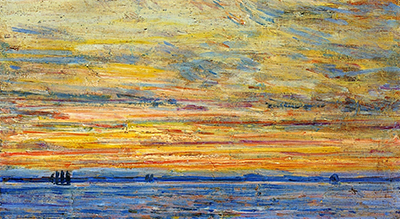This painting from the early 20th century can be described as one of Childe Hassam's most abstract artworks. It could well have been finished in a single sitting, featuring a simple blend of horizontal strokes of blue, orange and red tones.
The artist constructed this painting in 1907, at which point he would have been middle aged and well developed as an artist. Other than the bright sky and the blue calm sea, the only real details here are a number of small boats making their way across to our left. These were added with touches of black paint, probably after the initial work had dried. This was an artist working at his rawest, concentrating purely on colour and avoiding detail as much as possible. It represents how Impressionism had begun the path to abstraction, albeit with many more stages of development to be covered before we reached that point. One can compare this to the work of Piet Mondrian, for example, who slowly developed into a highly abstract painter after moving through periods of Expressionist art, with similarly abstract landscapes similar to this. A technical point to note within Evening is how the artist re-uses tones across different sections, bringing a consistency between how the light reflected colour around the scene.
Seascapes were common within his career but not in this style. Normally he would capture specific elements, such as rock formations or beaches and then place the rest of the scene around them. Within this piece, though, there is less of a direction of the eye, and each section is given as much importance as each other. Without the small boats it would really be more of a study in light and colour, served up as a seascape work. Indeed, it may have been that this artwork was more of an experiment or a preparation for another, more refined piece. Hassam worked tirelessly across his career, leaving several thousands of paintings by the end, and so it is inevitable that some of these would have been simpler pieces for the purposes of self expression and discovery, and not necessarily intended for the sales market at the time that he produced them.
Interest in his career has ensured that even lesser known pieces from his oeuvre will now command large valuations, just so long as a confident attribution to him can be found. Several efforts have been made to collate a full list of his achievements and so this particular piece can be confidently linked to the artist, not least because he signed it in the bottom left corner. Items within major institutions also tend to be well researched, with a full history available, covering their ownership from initial creation up to the present day. Hassam is a highly significant American painter who is known to most of the American art public and his concentration on some famous venues and events has also brought his work to the attention of many others too.




